Effect of cultural familiarity on reading comprehension performance: a casestudy of vietnamese and chilean efl learners
This paper investigates the influence of cultural background knowledge on EFL
reading comprehension. To explore the general assumption that cultural background
knowledge helps students to better comprehend a text, a reading comprehension test
including two passages describing a Vietnamese and a Chilean national holiday was
developed. Forty one Vietnamese and 35 Chilean students took the test. A brief
questionnaire was also used to examine students’ perceptions of their familiarity with the
texts based on their background knowledge. Results from the t-tests revealed statistically
significant differences between the two groups. Both Vietnamese and Chilean students
respectively outperformed the other group in the test section about their national holiday,
which suggested a positive influence of cultural background knowledge. Weak but
significant correlations were found between students’ reported familiarity with the texts and
their scores in each section. The findings of this study provide some relevant implications
for language testing and second language instruction.
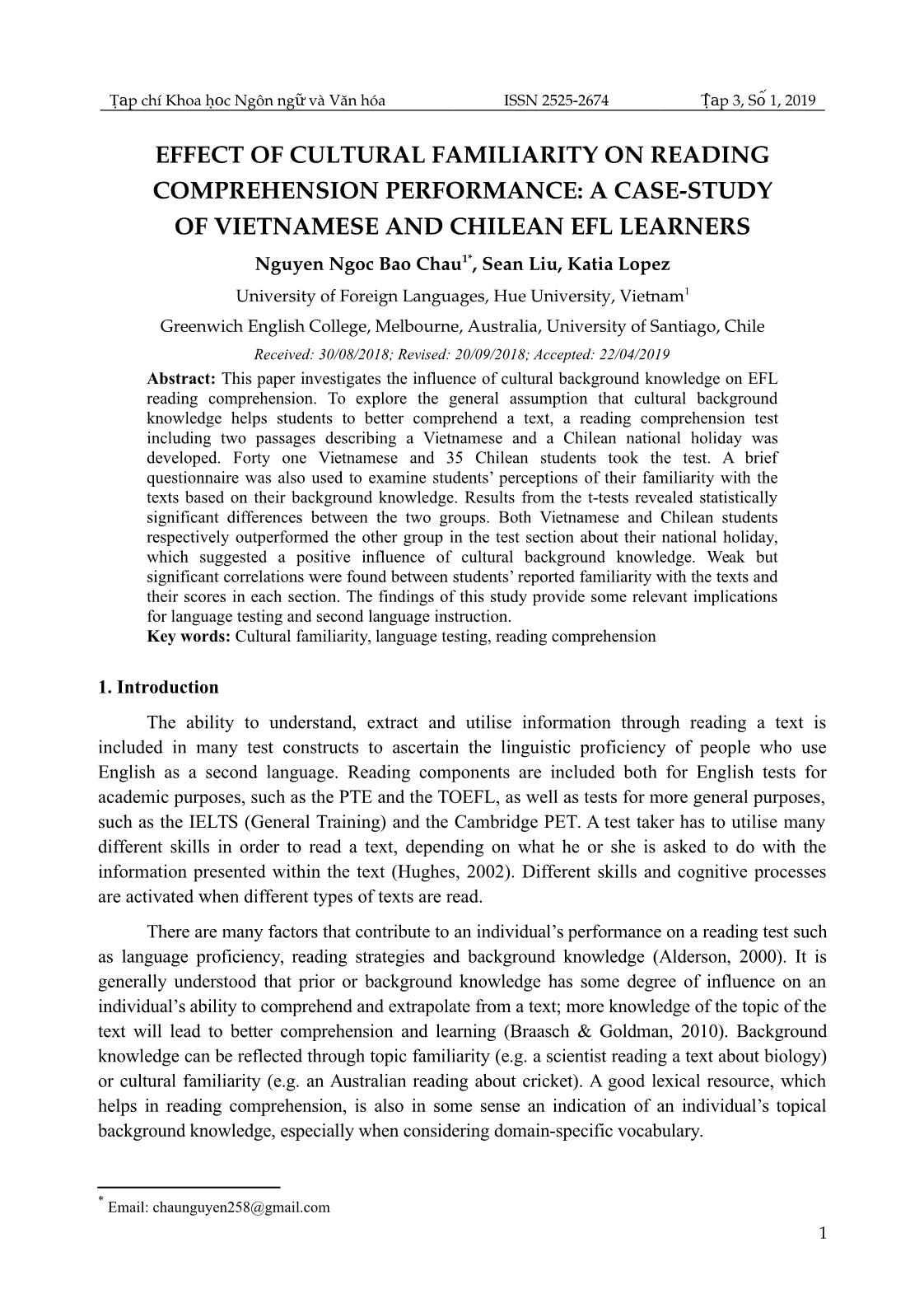
Trang 1
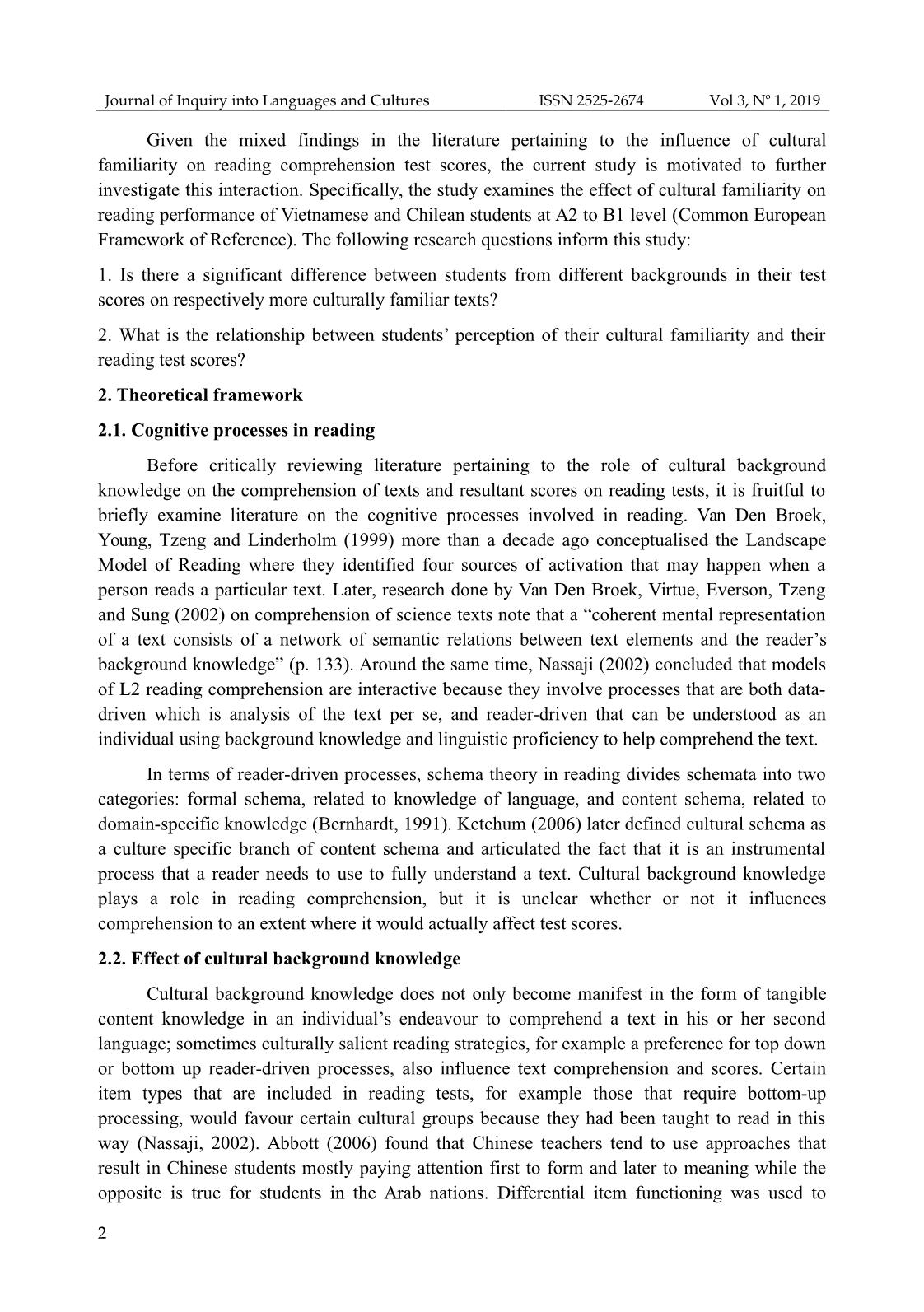
Trang 2
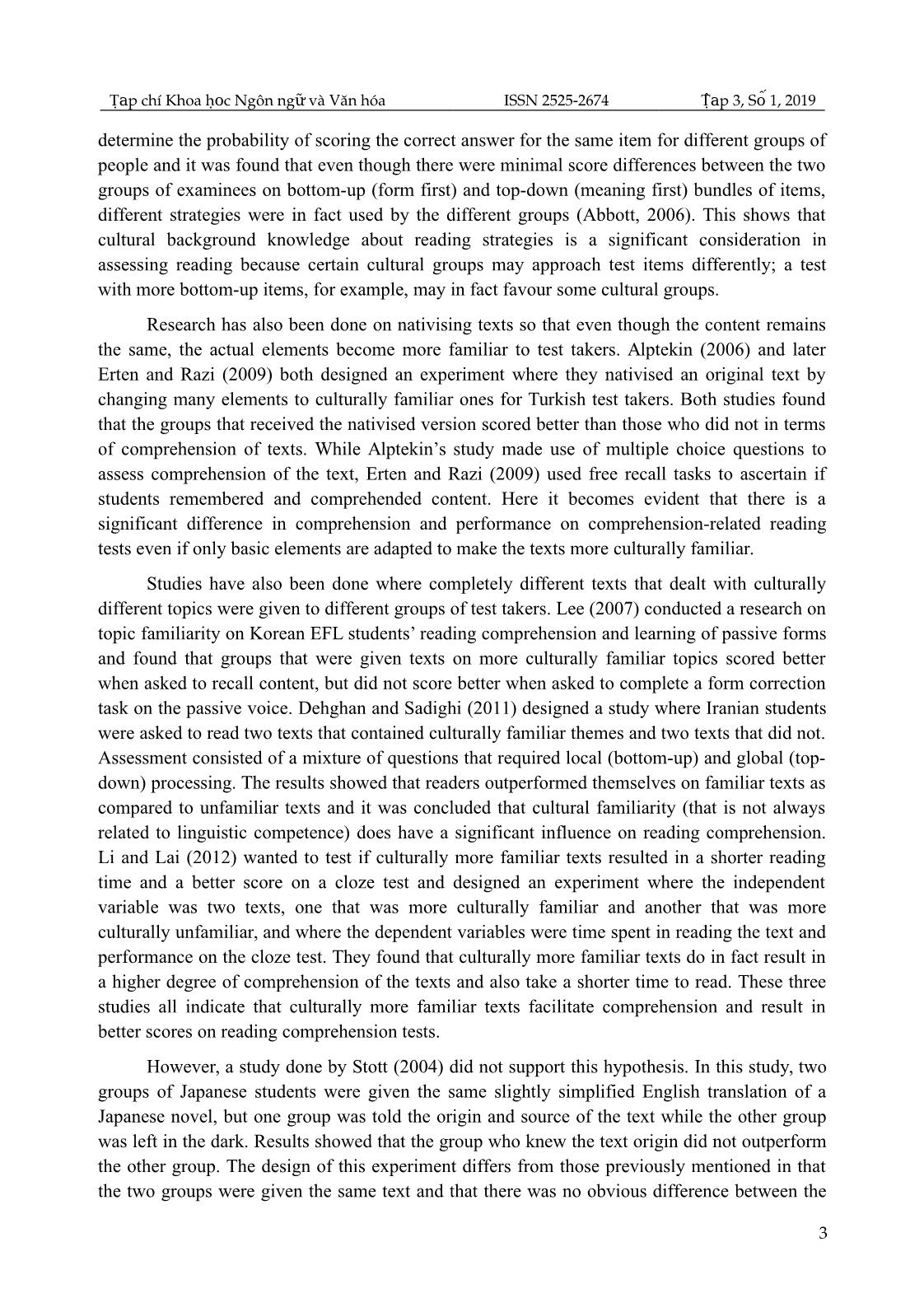
Trang 3
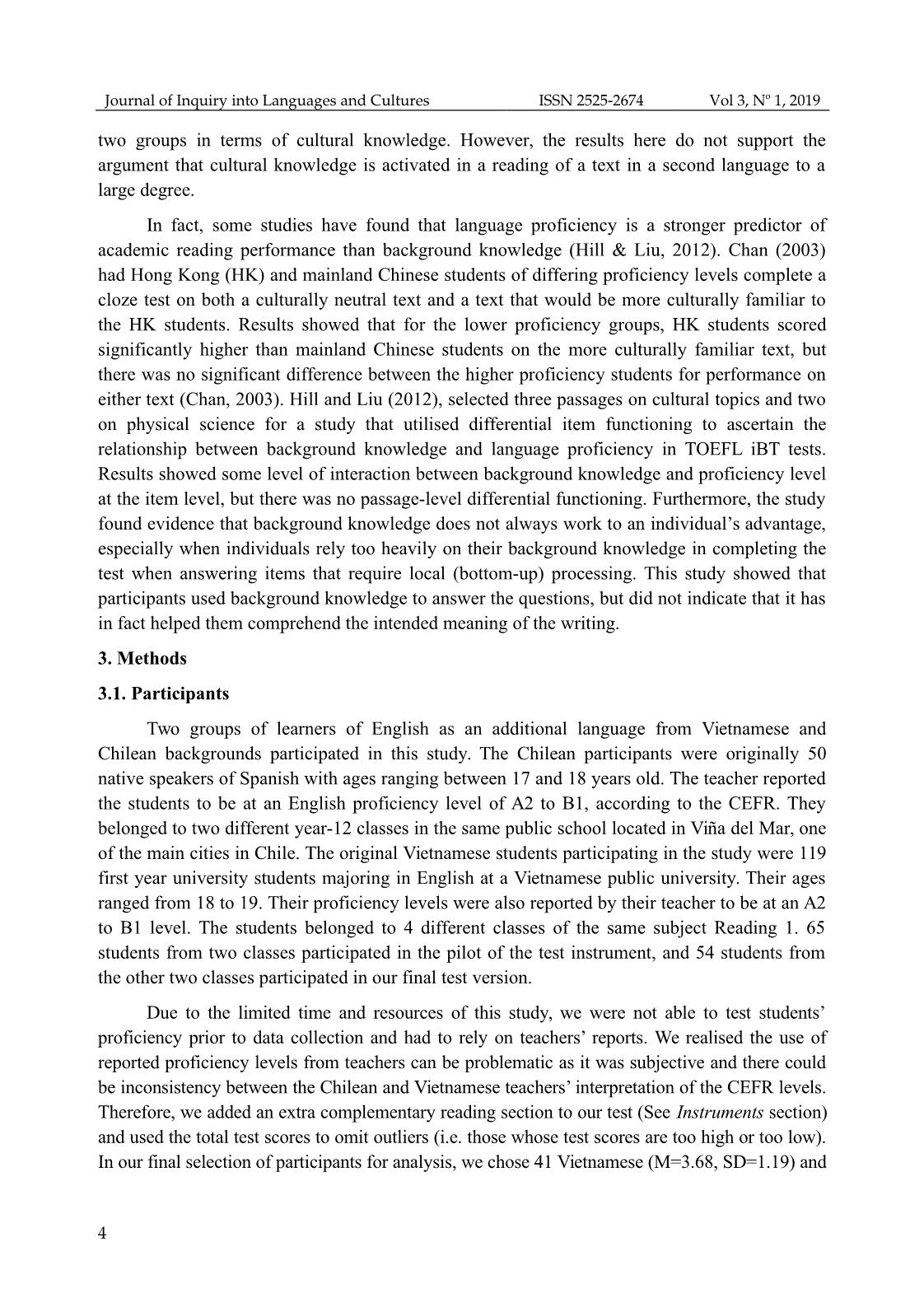
Trang 4
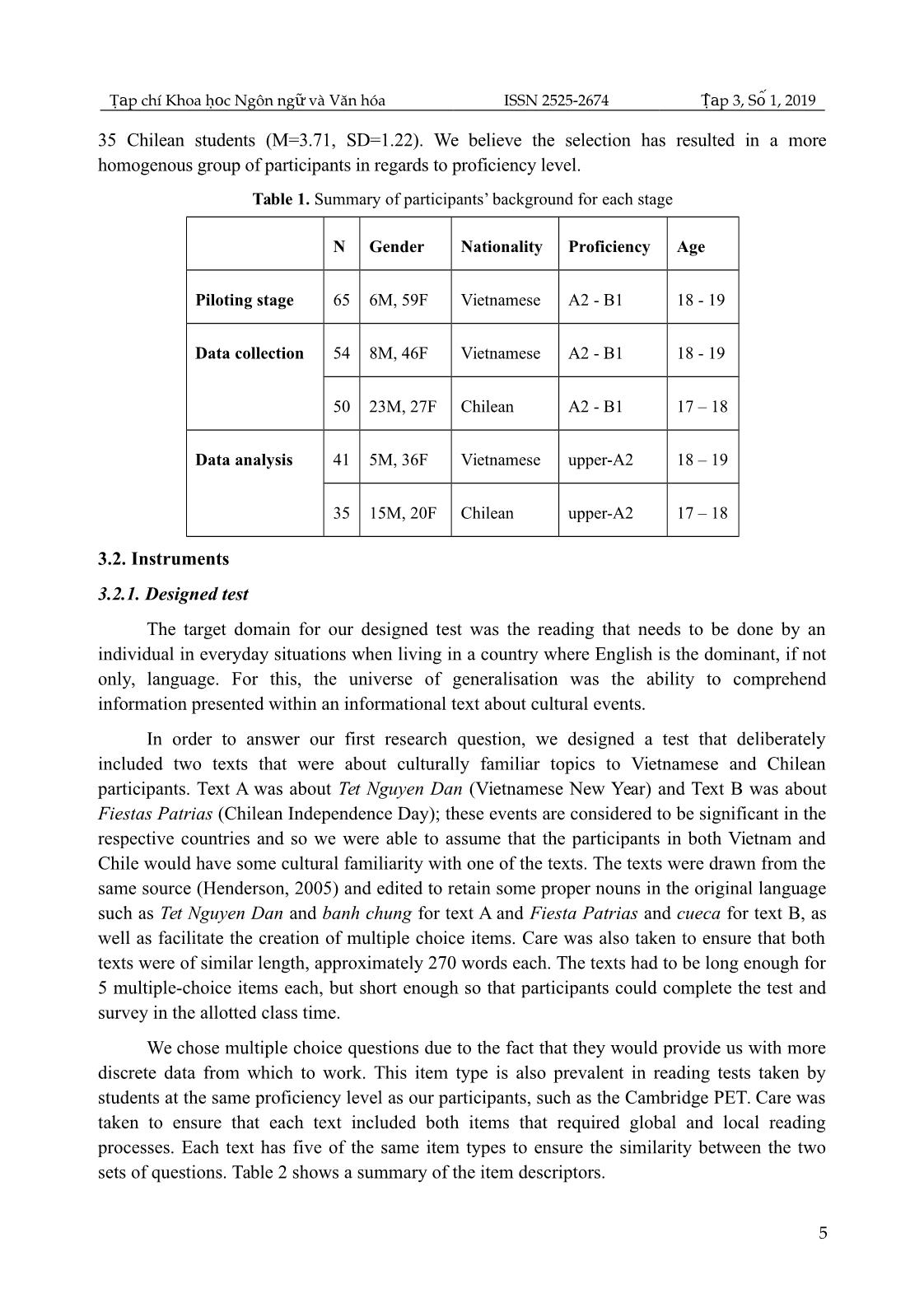
Trang 5
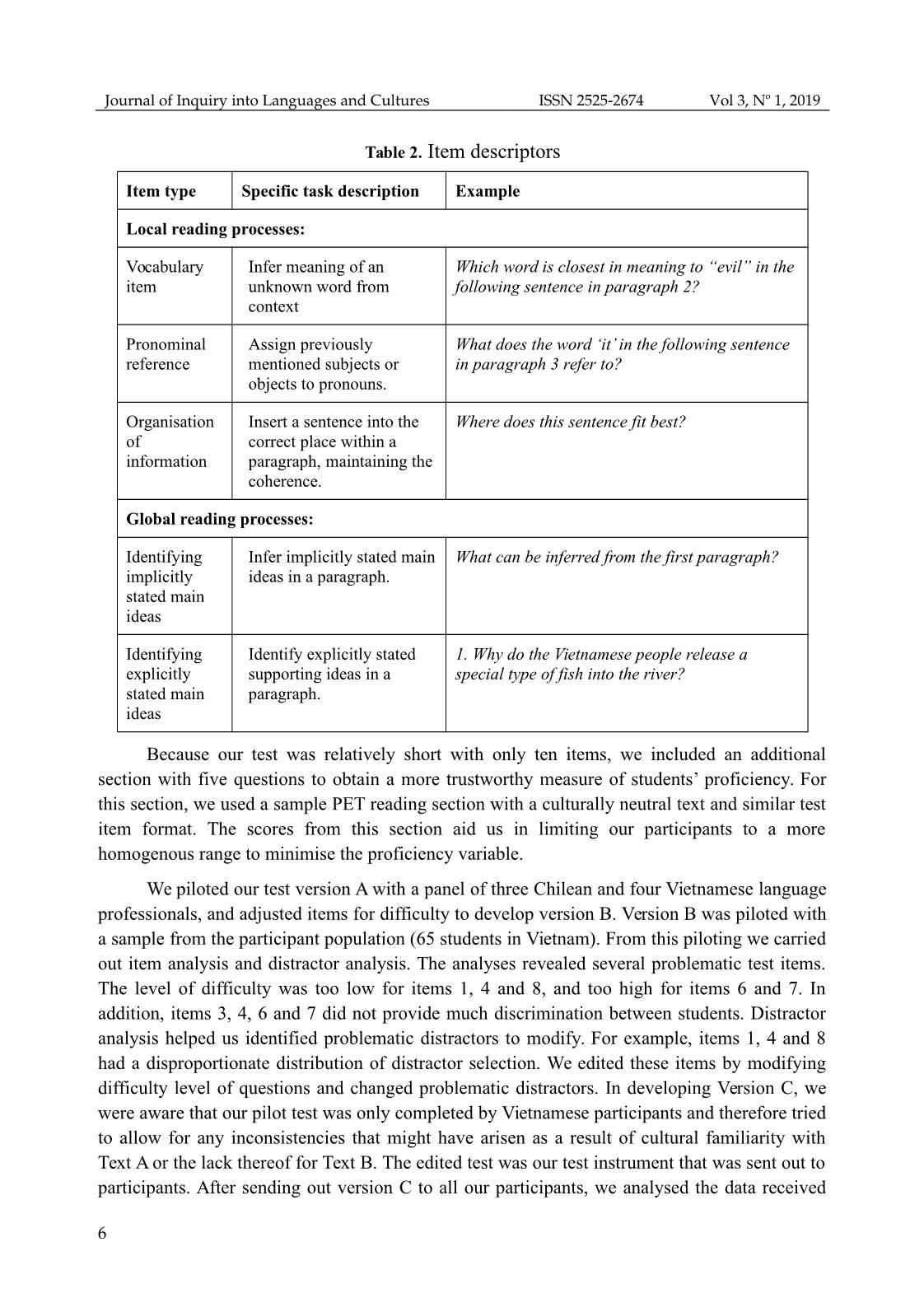
Trang 6
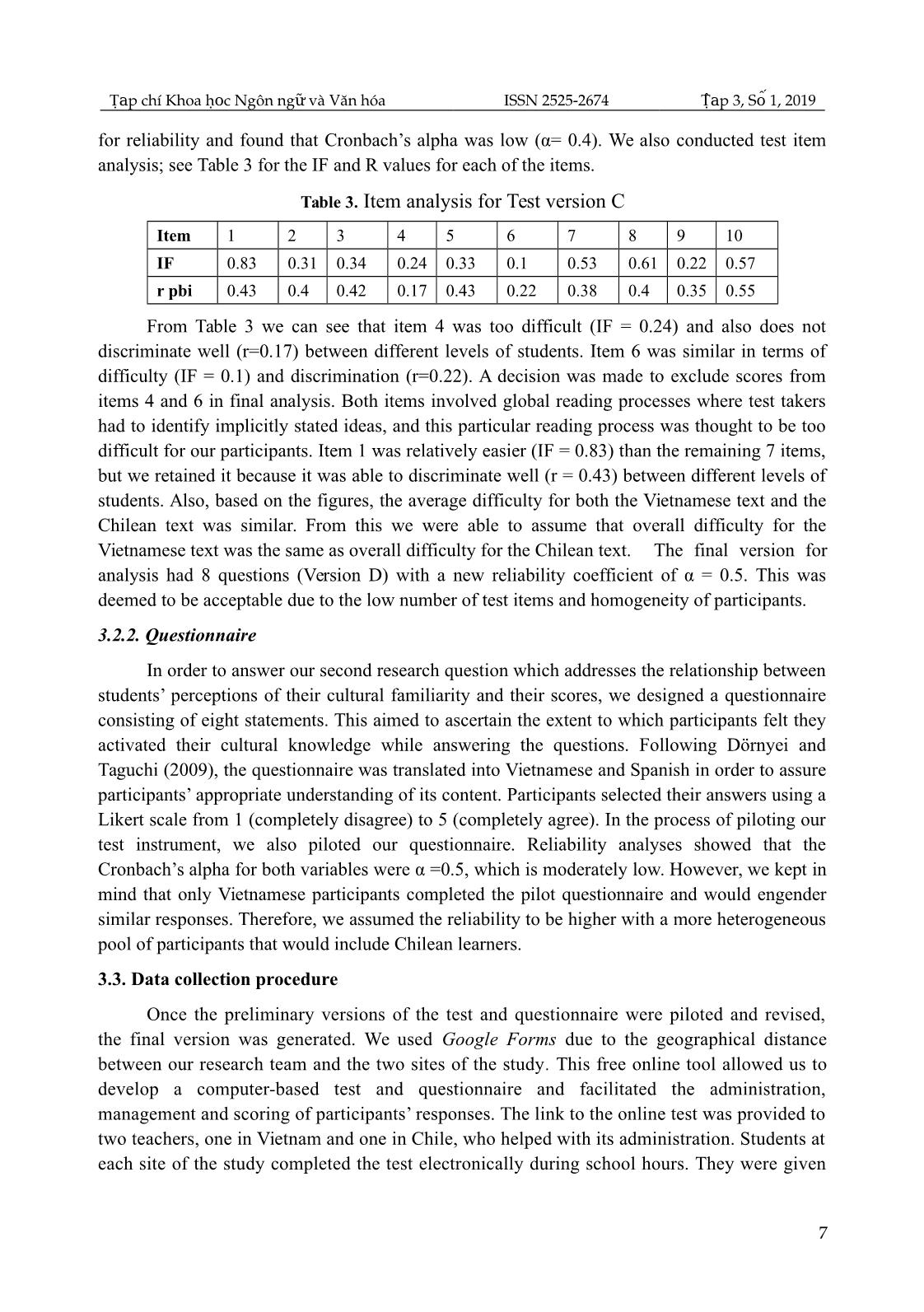
Trang 7
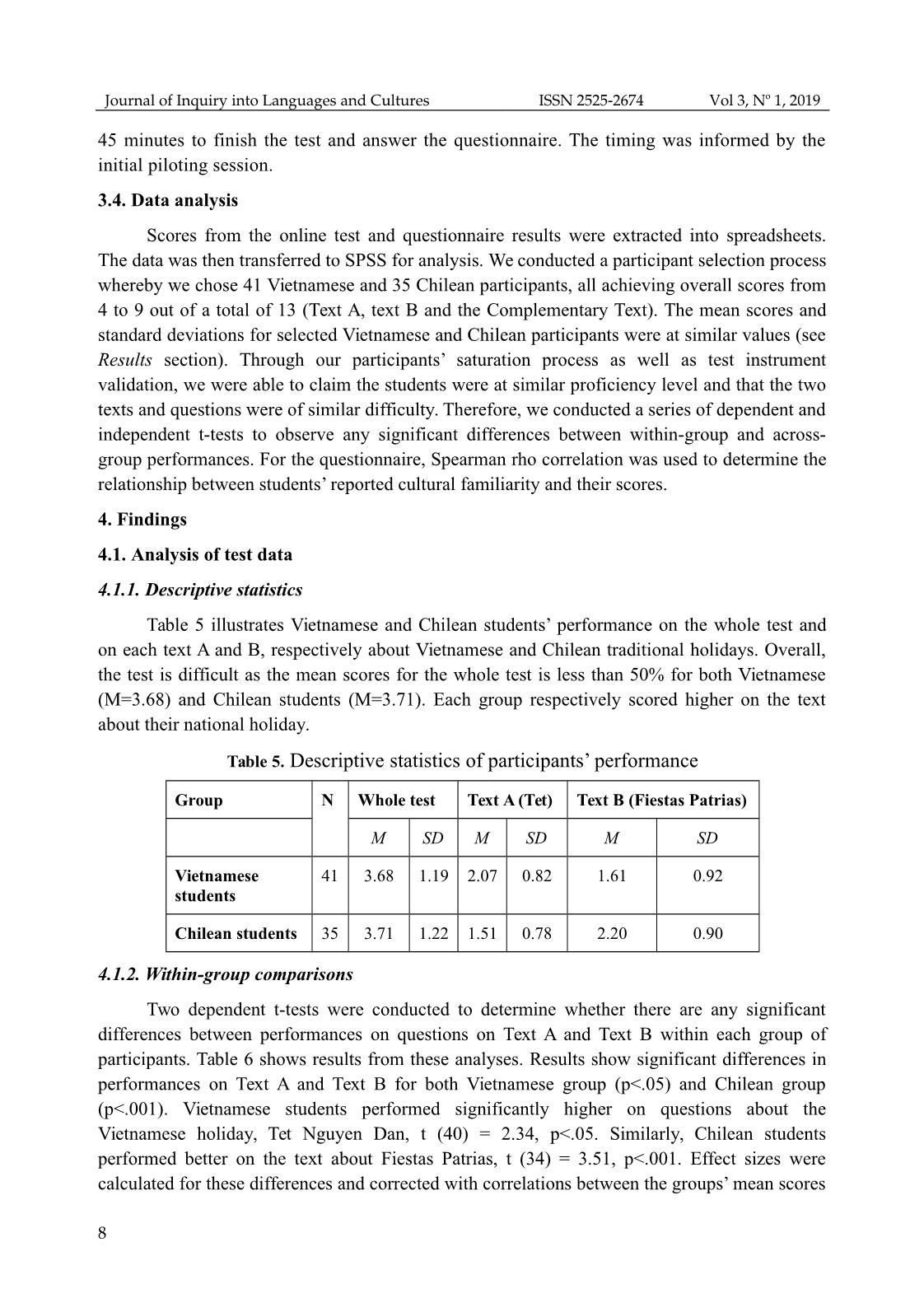
Trang 8
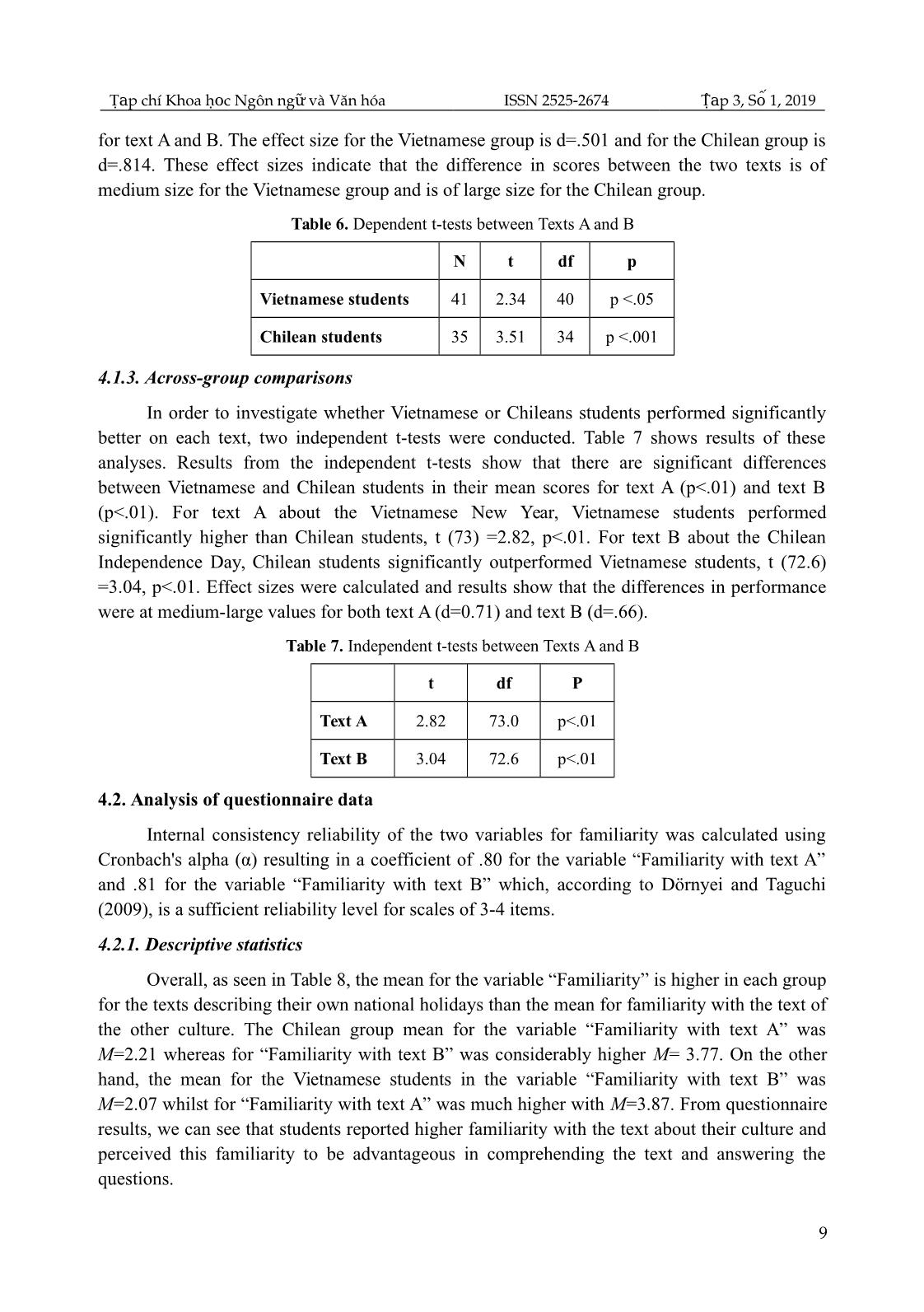
Trang 9
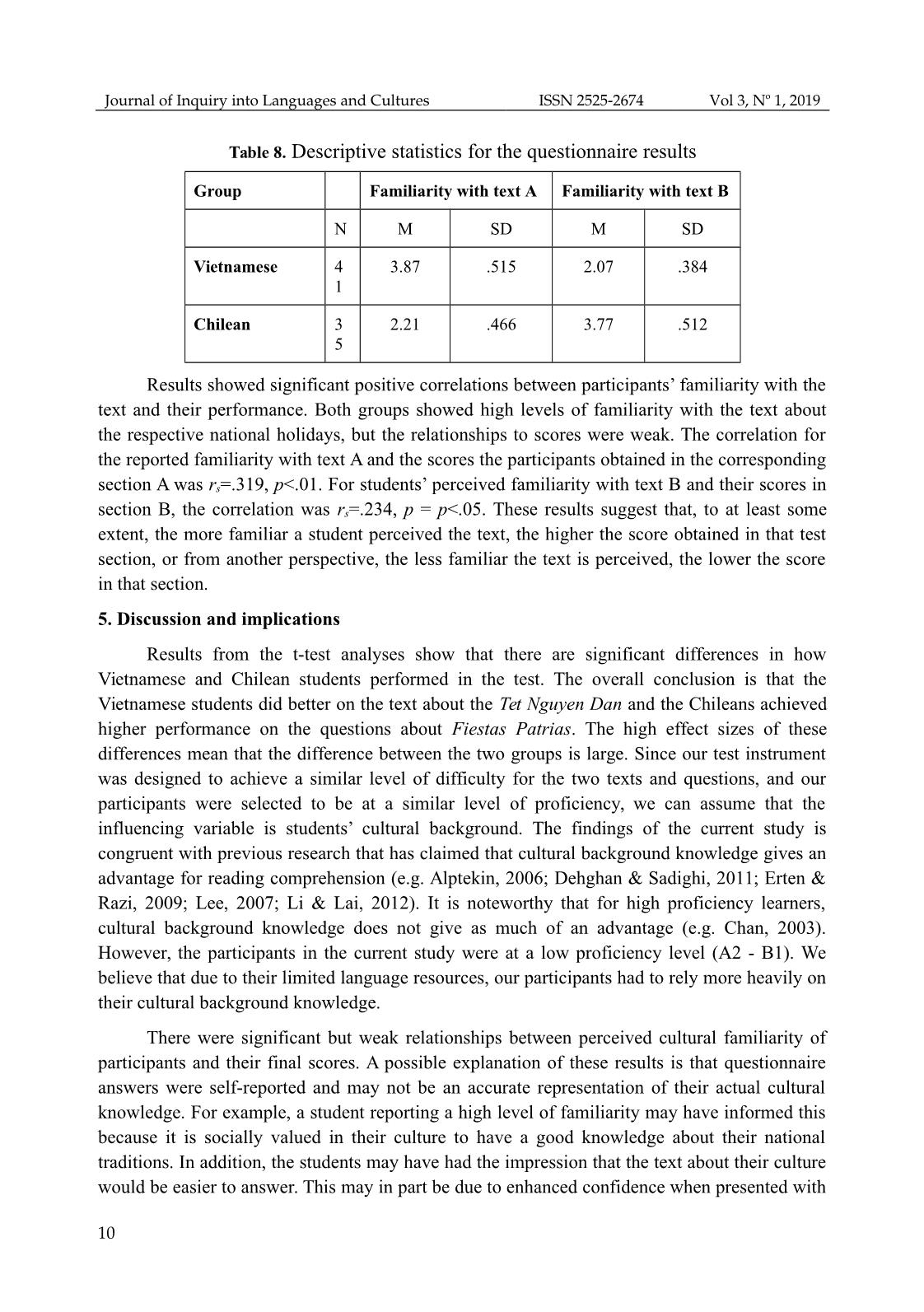
Trang 10
Tải về để xem bản đầy đủ
Tóm tắt nội dung tài liệu: Effect of cultural familiarity on reading comprehension performance: a casestudy of vietnamese and chilean efl learners
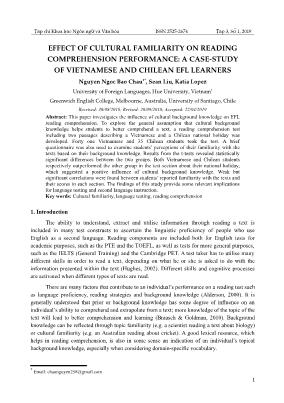
T p chí Khoa h c Ngôn ng và Văn hóaạ ọ ữ ISSN 25252674 T p 3, S 1, 2019ậ ố EFFECT OF CULTURAL FAMILIARITY ON READING COMPREHENSION PERFORMANCE: A CASESTUDY OF VIETNAMESE AND CHILEAN EFL LEARNERS Nguyen Ngoc Bao Chau1*, Sean Liu, Katia Lopez University of Foreign Languages, Hue University, Vietnam1 Greenwich English College, Melbourne, Australia, University of Santiago, Chile Received: 30/08/2018; Revised: 20/09/2018; Accepted: 22/04/2019 Abstract: This paper investigates the influence of cultural background knowledge on EFL reading comprehension. To explore the general assumption that cultural background knowledge helps students to better comprehend a text, a reading comprehension test including two passages describing a Vietnamese and a Chilean national holiday was developed. Forty one Vietnamese and 35 Chilean students took the test. A brief questionnaire was also used to examine students’ perceptions of their familiarity with the texts based on their background knowledge. Results from the t-tests revealed statistically significant differences between the two groups. Both Vietnamese and Chilean students respectively outperformed the other group in the test section about their national holiday, which suggested a positive influence of cultural background knowledge. Weak but significant correlations were found between students’ reported familiarity with the texts and their scores in each section. The findings of this study provide some relevant implications for language testing and second language instruction. Key words: Cultural familiarity, language testing, reading comprehension 1. Introduction The ability to understand, extract and utilise information through reading a text is included in many test constructs to ascertain the linguistic proficiency of people who use English as a second language. Reading components are included both for English tests for academic purposes, such as the PTE and the TOEFL, as well as tests for more general purposes, such as the IELTS (General Training) and the Cambridge PET. A test taker has to utilise many different skills in order to read a text, depending on what he or she is asked to do with the information presented within the text (Hughes, 2002). Different skills and cognitive processes are activated when different types of texts are read. There are many factors that contribute to an individual’s performance on a reading test such as language proficiency, reading strategies and background knowledge (Alderson, 2000). It is generally understood that prior or background knowledge has some degree of influence on an individual’s ability to comprehend and extrapolate from a text; more knowledge of the topic of the text will lead to better comprehension and learning (Braasch & Goldman, 2010). Background knowledge can be reflected through topic familiarity (e.g. a scientist reading a text about biology) or cultural familiarity (e.g. an Australian reading about cricket). A good lexical resource, which helps in reading comprehension, is also in some sense an indication of an individual’s topical background knowledge, especially when considering domain-specific vocabulary. * Email: chaunguyen258@gmail.com 1 Journal of Inquiry into Languages and Cultures ISSN 25252674 Vol 3, No 1, 2019 Given the mixed findings in the literature pertaining to the influence of cultural familiarity on reading comprehension test scores, the current study is motivated to further investigate this interaction. Specifically, the study examines the effect of cultural familiarity on reading performance of Vietnamese and Chilean students at A2 to B1 level (Common European Framework of Reference). The following research questions inform this study: 1. Is there a significant difference between students from different backgrounds in their test scores on respectively more culturally familiar texts? 2. What is the relationship between students’ perception of their cultural familiarity and their reading test scores? 2. Theoretical framework 2.1. Cognitive processes in reading Before critically reviewing literature pertaining to the role of cultural background knowledge on the comprehension of texts and resultant scores on reading tests, it is fruitful to briefly examine literature on the cognitive processes involved in reading. Van Den Broek, Young, Tzeng and Linderholm (1999) more than a decade ago conceptualised the Landscape Model of Reading where they identified four sources of activation that may happen when a person reads a particular text. Later, research done by Van Den Broek, Virtue, Everson, Tzeng and Sung (2002) on comprehension of science texts note that a “coherent mental representation of a text consists of a network of semantic relations between text elements and the reader’s background knowledge” (p. 133). Around the same time, Nassaji (2002) concluded that models of L2 reading comprehension are interactive because they involve processes that are both data- driven which is analysis of the text per se, and reader-driven that can be understood as an individual using background knowledge and linguistic proficiency to help comprehend the text. In terms of reader-driven processes, schema theory in reading divides schemata into two categories: formal schema, related to knowledge of language, and content schema, related to domain-specific knowledge (Bernhardt, 1991). Ketchum (2006) later defined cultural schema as a culture specific branch of content schema and articulated the fact that it is an instrumental process that a reader needs to use to fully understand a text. Cultural background knowledge plays a role in reading comprehension, but it is unclear whether or not it influences comprehension to an extent where it would actually affect test scores. 2.2. Effect of cultural background knowledge Cultural background knowledge does not only become manifest in the form of tangible content knowledge in a ... s from these analyses. Results show significant differences in performances on Text A and Text B for both Vietnamese group (p<.05) and Chilean group (p<.001). Vietnamese students performed significantly higher on questions about the Vietnamese holiday, Tet Nguyen Dan, t (40) = 2.34, p<.05. Similarly, Chilean students performed better on the text about Fiestas Patrias, t (34) = 3.51, p<.001. Effect sizes were calculated for these differences and corrected with correlations between the groups’ mean scores 8 T p chí Khoa h c Ngôn ng và Văn hóaạ ọ ữ ISSN 25252674 T p 3, S 1, 2019ậ ố for text A and B. The effect size for the Vietnamese group is d=.501 and for the Chilean group is d=.814. These effect sizes indicate that the difference in scores between the two texts is of medium size for the Vietnamese group and is of large size for the Chilean group. Table 6. Dependent t-tests between Texts A and B N t df p Vietnamese students 41 2.34 40 p <.05 Chilean students 35 3.51 34 p <.001 4.1.3. Across-group comparisons In order to investigate whether Vietnamese or Chileans students performed significantly better on each text, two independent t-tests were conducted. Table 7 shows results of these analyses. Results from the independent t-tests show that there are significant differences between Vietnamese and Chilean students in their mean scores for text A (p<.01) and text B (p<.01). For text A about the Vietnamese New Year, Vietnamese students performed significantly higher than Chilean students, t (73) =2.82, p<.01. For text B about the Chilean Independence Day, Chilean students significantly outperformed Vietnamese students, t (72.6) =3.04, p<.01. Effect sizes were calculated and results show that the differences in performance were at medium-large values for both text A (d=0.71) and text B (d=.66). Table 7. Independent t-tests between Texts A and B t df P Text A 2.82 73.0 p<.01 Text B 3.04 72.6 p<.01 4.2. Analysis of questionnaire data Internal consistency reliability of the two variables for familiarity was calculated using Cronbach's alpha (α) resulting in a coefficient of .80 for the variable “Familiarity with text A” and .81 for the variable “Familiarity with text B” which, according to Dörnyei and Taguchi (2009), is a sufficient reliability level for scales of 3-4 items. 4.2.1. Descriptive statistics Overall, as seen in Table 8, the mean for the variable “Familiarity” is higher in each group for the texts describing their own national holidays than the mean for familiarity with the text of the other culture. The Chilean group mean for the variable “Familiarity with text A” was M=2.21 whereas for “Familiarity with text B” was considerably higher M= 3.77. On the other hand, the mean for the Vietnamese students in the variable “Familiarity with text B” was M=2.07 whilst for “Familiarity with text A” was much higher with M=3.87. From questionnaire results, we can see that students reported higher familiarity with the text about their culture and perceived this familiarity to be advantageous in comprehending the text and answering the questions. 9 Journal of Inquiry into Languages and Cultures ISSN 25252674 Vol 3, No 1, 2019 Table 8. Descriptive statistics for the questionnaire results Group Familiarity with text A Familiarity with text B N M SD M SD Vietnamese 4 1 3.87 .515 2.07 .384 Chilean 3 5 2.21 .466 3.77 .512 Results showed significant positive correlations between participants’ familiarity with the text and their performance. Both groups showed high levels of familiarity with the text about the respective national holidays, but the relationships to scores were weak. The correlation for the reported familiarity with text A and the scores the participants obtained in the corresponding section A was rs=.319, p<.01. For students’ perceived familiarity with text B and their scores in section B, the correlation was rs=.234, p = p<.05. These results suggest that, to at least some extent, the more familiar a student perceived the text, the higher the score obtained in that test section, or from another perspective, the less familiar the text is perceived, the lower the score in that section. 5. Discussion and implications Results from the t-test analyses show that there are significant differences in how Vietnamese and Chilean students performed in the test. The overall conclusion is that the Vietnamese students did better on the text about the Tet Nguyen Dan and the Chileans achieved higher performance on the questions about Fiestas Patrias. The high effect sizes of these differences mean that the difference between the two groups is large. Since our test instrument was designed to achieve a similar level of difficulty for the two texts and questions, and our participants were selected to be at a similar level of proficiency, we can assume that the influencing variable is students’ cultural background. The findings of the current study is congruent with previous research that has claimed that cultural background knowledge gives an advantage for reading comprehension (e.g. Alptekin, 2006; Dehghan & Sadighi, 2011; Erten & Razi, 2009; Lee, 2007; Li & Lai, 2012). It is noteworthy that for high proficiency learners, cultural background knowledge does not give as much of an advantage (e.g. Chan, 2003). However, the participants in the current study were at a low proficiency level (A2 - B1). We believe that due to their limited language resources, our participants had to rely more heavily on their cultural background knowledge. There were significant but weak relationships between perceived cultural familiarity of participants and their final scores. A possible explanation of these results is that questionnaire answers were self-reported and may not be an accurate representation of their actual cultural knowledge. For example, a student reporting a high level of familiarity may have informed this because it is socially valued in their culture to have a good knowledge about their national traditions. In addition, the students may have had the impression that the text about their culture would be easier to answer. This may in part be due to enhanced confidence when presented with 10 T p chí Khoa h c Ngôn ng và Văn hóaạ ọ ữ ISSN 25252674 T p 3, S 1, 2019ậ ố a foreign language text with more familiar cultural elements (e.g. Erten & Razi, 2009). Furthermore, the activation of background cultural knowledge only provides a certain amount of support, especially with lower proficiency learners (e.g. Chan, 2003; Hill & Liu, 2012). These correlation results, albeit not strong, support the results from the t-tests in that there can be a positive influence from background knowledge on students’ scores. A significant limitation of this research would be the length of the test. Due to limited time and resources, our final instrument, Version D, had only four multiple choice questions per text. We were not able to include items that tested for the full range of global and local processes involved in reading. We were only able to get a gauge of student proficiency levels through their performance on 13 items. Further research can be done on a wider scale with a larger population of participants of different backgrounds and proficiency levels. It is suggested that future research include other test instruments to ascertain actual, as opposed to perceived, cultural background knowledge. 6. Conclusion The study has implications on research in validating existing language tests, especially those that are not L1 independent. Fairness review guidelines (for example by ETS) have stressed the representation of diverse ethnic groups in tests. However, in the process of ensuring diversity, test developers have to take care not to inadvertently advantage certain groups of test takers. Apart from the implications in the field of second language testing, the results in this study can also have some implications in second language learning and teaching. In line with Alderson (2000), the results in our test and questionnaire suggested that more a familiar text would facilitate reading, comprehension and processing of the content in a text. Exposure to more familiar topics would also help students to recall information more easily (Erten and Razi, 2009; Lee, 2007). Familiarity can also benefit vocabulary learning since students can remember new words better when they associate them to content that is more significant (Alderson, 2000), as in the case of the national holidays in our test. These considerations can be taken into account in terms the selection of teaching material for language classes. This does not mean that unfamiliar topics should be avoided; on the contrary, students need to be provided with a range of different topics that reflect the scenarios that they will face in real life when exposed to the second language. However, in the first stages of learning, when learners’ proficiency is low, we propose that using culturally familiar topics can be a good strategy to reinforce learning process and the development of their language skills in L2, as well as to help promote learners’ confidence and motivation. References Abbott, M.L. (2006). ESL reading strategies: Differences in Arabic and Mandarin speaker test performance. Language Learning, 56(4), 633-670. Alderson, J.C. (2000). Assessing reading. Cambridge: Cambridge University Press. Alptekin, C. (2006). Cultural familiarity in inferential and literal comprehension in L2 reading. System: An International Journal of Educational Technology and Applied Linguistics, 34(4), 494-508. Bernhardt, E. (1991). Reading development in a second language. New York: Ablex. 11 Journal of Inquiry into Languages and Cultures ISSN 25252674 Vol 3, No 1, 2019 Braasch, J.L., & Goldman, S.R. (2010). The role of prior knowledge in learning from analogies in science texts. Discourse Processes, 47(6), 447-479. Chan, C.H. (2003). Cultural content and reading proficiency: A comparison of mainland Chinese and Hong Kong learners of English. Language, Culture and Curriculum, 16(1), 60-69. Dehghan, F., & Sadighi, F. (2011). On the cultural schema and Iranian EFL learners' reading performance: A case of local and global items. Journal of Pan-Pacific Association of Applied Linguistics, 15(2), 97-108. Dörnyei, Z., & Taguchi, T. (2009). Questionnaires in second language research: Construction, administration, and processing. Abington on Thames: Routledge. Erten, I.H., & Razi, S. (2009). The effects of cultural familiarity on reading comprehension. Reading in a Foreign Language, 21(1), 60-77. Exam English Ltd. (2014). Cambridge English preliminary (PET) reading part 4 comprehension questions. Retrieved from: www.examenglish.com/PET/pet_reading4_test2.html. Henderson, H. (2005). Holidays, festivals, and celebration of the world dictionary. Detroit, MI: Omnigraphics Inc. Hill, Y.Z., & Liu, O.L. (2012). Is there any interaction between background knowledge and language proficiency that affects TOEFL iBT reading performance?. ETS Research Report Series, 2, i-34. Hughes, A. (2002). Testing for language teachers. Cambridge: Cambridge University Press. Ketchum, E.M. (2006). The cultural baggage of second language reading: An approach to understanding the practices and perspectives of nonnative products. Foreign Language Annals, 39(1), 22-42. Lee, S. (2007). Effects of textual enhancement and topic familiarity on Korean EFL students' reading comprehension and learning of passive form. Language Learning, 57(1), 87-118. DOI:10.1111/j.1467- 9922.2007.00400.x. Li, C., & Lai, S. (2012). The functions of cultural schemata in the Chinese reading comprehension and reading time of college students in Taiwan. Journal of International Education Research, 8(2), 105- 112. Nassaji, H. (2002). Schema theory and knowledge-based processes in second language reading comprehension: A need for alternative perspectives. Language Learning, 52(2), 439-481. Stott, N. (2004). Familiarity breeds contempt: Reading texts from learners' own cultures does not guarantee recall. TESOL Quarterly, 38(2), 345-352. Van Den Broek, P., Virtue, S., Everson, M.G., Tzeng, Y., & Sung, Y.C. (2002). Comprehension and memory of science texts: Inferential processes and the construction of a mental representation. In A. Graesser, J. Otero, & J. Leon (Eds.), The psychology of science text comprehension (pp. 131-154). Mahwah: L. Erlbaum Associates. Van Den Broek, P., Young, M., Tzeng, Y., & Linderholm, T. (1999). The landscape model of reading: Inferences and the online construction of a memory representation. In H. Van Oostendorp & S.R. Goldman (Eds.), The construction of mental representations during reading (pp. 71-98). Abingdon on Thames: Psychology Press. NH H NG C A KI N TH C N N T NG VĂN HÓA Ả ƯỞ Ủ Ế Ứ Ề Ả T I KH NĂNG Đ C HI U TI NG ANH Ớ Ả Ọ Ể Ế 12 T p chí Khoa h c Ngôn ng và Văn hóaạ ọ ữ ISSN 25252674 T p 3, S 1, 2019ậ ố NH LÀ M T NGO I NG : M T NGHIÊN C U ĐI N HÌNH Ư Ộ Ạ Ữ Ộ Ứ Ể V NG I H C VI T NAM VÀ CHILEỀ ƯỜ Ọ Ệ Tóm tắt: Để nghiên cứu ảnh hưởng của kiến thức nền tảng văn hóa tới khả năng đọc hiểu, một bài kiểm tra đọc hiểu gồm hai đoạn về ngày lễ Việt Nam và Chile đã được phát triển. Bài kiểm tra được thực hiện bởi người học Việt Nam (N=41) và Chile (N=35). Một bảng câu hỏi được sử dụng để kiểm tra nhận thức của người học về sự quen thuộc với các văn bản dựa trên kiến thức nền tảng. Kết quả t-tests cho thấy có sự khác biệt có ý nghĩa thống kê giữa hai nhóm, cho thấy ảnh hưởng tích cực của kiến thức nền văn hóa. Các mối tương quan đã được tìm thấy giữa sự quen thuộc với các bản văn và điểm số. Phát hiện của nghiên cứu cung cấp một số ý nghĩa liên quan đến kiểm tra và dạy học ngoại ngữ. Từ khóa: Hiểu biết văn hóa, kiểm tra ngoại ngữ, đọc hiểu 13
File đính kèm:
 effect_of_cultural_familiarity_on_reading_comprehension_perf.pdf
effect_of_cultural_familiarity_on_reading_comprehension_perf.pdf

